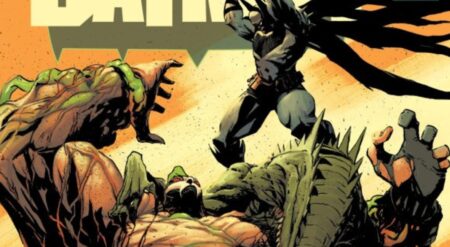
The Flash #784 is a Dark Crisis Tie-in published by DC Comics, written by Jeremy Adams, art by Amancay Nahuelpan, colours by Jeromy Cox, and letters by Rob Leigh. In the last issue, the Flash Family split up into three different Earths to search for Barry Allen. In this issue, they all find themselves in trouble in their new surroundings.
Where the last chapter struggles to build up speed, this issue takes off running and does not stop. The story splits into three, all set in different worlds with unique sub-genres. One is based on Mad Max, the second is a spin on a Batman comic, and the third has a Silver-age Archie tone. The focus is maintained well by Adams in The Flash #784, as each story is given its own segment instead of routinely jumping between the worlds. This allows for the tales to be individual.
The three Earths could all be full comics by themselves; such is the depth created. Every reveal the issue does is very surprising and creates a sense of danger, with some incredibly fun and new ideas being trialed by the writer. There is a powerful set piece three times, three more than were held in the previous issue. The potential directions that the story could go in leaves this comic very difficult to predict.
Many of the characters introduced in The Flash #784 are fascinating but only very briefly touched on. Because the story has to move so fast, it is the concept they embody that has to come across most importantly. Perhaps the most interesting of the Barry Allens is the final one, influenced by the SIlver-Age. At first glance, he comes across as cheerful and obnoxiously positive. But that rapidly shifts when he faces danger. Many of the Flash Family are also given little chance to demonstrate their distinct personalities, all flung into action instantly. Wally’s kids and their panic may be the most captivating in the second Earth, and Wally himself is brilliantly written, but the others need to demonstrate more personality.
The art is fantastic. Each world looks completely unique as Nahuelpan adapts their style to fit the landscape. In the Mad Max world, the open desert is captured beautifully. The first couple of pages are in constant motion, and it sets a great pace for the rest of the issue to match. The second world is bathed in shadow, accentuating the darkness. The alleyways and tall buildings already denote Gotham, but the silhouettes also help. Turning this version of the Flash into a monster leads to a superb design that truly is unique. It amalgamates two heroes into one look, and it is a brilliant idea. The third story relishes a classic style, with very clean lines and dotted textures. It’s an excellent contrast to the shadowy Earth that came before it. The expressions on the characters’ faces are amazingly specific, and whilst overexaggerated, they are deeply emotive.
The colours are stunningly vibrant. That signature red, ever-present in this book and this character, is the constant thread running through all of the Earths. There are small deviations in tone, but it is such an iconic shade that any major change may be considered to be blasphemous. The lettering is very clear and dynamic. The narrator in the caption boxes alters depending on the Earth, but the colour changes make it easy to understand.
The Flash #784 is a brilliant injection of pace to the series. The three separate stories that are running parallel to each other bring with them unique settings and characters, all variations on the same character. The energy this comic contains is infectious and so much fun. It is full of content and incredibly exciting events brought to life with gorgeous art that is able to adapt to fit the needs of the story.
The Flash #784 is available where comics are sold.
The Flash #784
TL;DR
The Flash #784 is a brilliant injection of pace to the series. The three separate stories that are running parallel to each other bring with them unique settings and characters. The energy this comic contains is infectious and so much fun. It is full of content and incredibly exciting events brought to life with gorgeous art that is able to adapt to fit the needs of the story.







